You want readers to love your story, to pick up your book and be so immersed they won't be able to put it down.
To do that, though, you need to have a great plot. But what is plot, and how do you craft one into a great story?
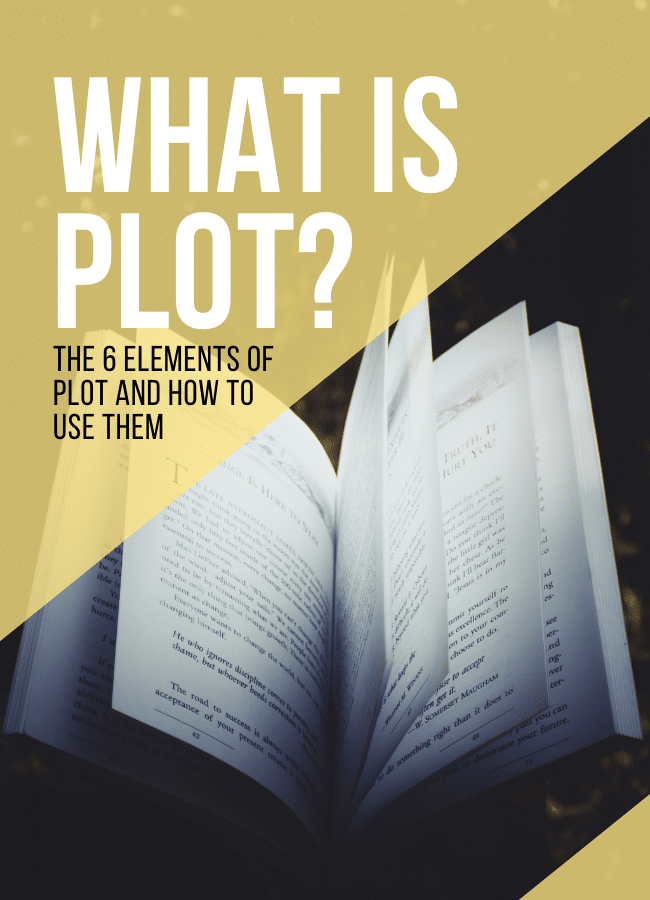
In this guide, we're going to talk about plot in literature. I'll share a broad definition of plot, then dive into the approach we use at The Write Practice (called The Write Structure). Finally, you'll learn the six elements of plot that make stories entertaining and memorable.
Click to Join the Class!
We'll look at a few examples of how these elements work in bestselling stories. We'll touch on story arcs, the different shapes a plot of a story can take. We'll also look at several plot diagrams to better understand how plot works visually. Finally, you'll learn exactly how you can use your new understanding of plot in your own stories.
You can read the guide below or watch the video lesson here:
This article contains an excerpt from our book The Write Structure, which is a timeless approach to storytelling and structure. You can learn more about it here.
What Is Plot? Plot Definition
Plot is a sequence of events in a story in which the main character is put into a challenging situation that forces them to make increasingly difficult choices, driving the story toward a climactic event and resolution.
What are the 6 Elements of Plot and Structure
We will define each below, but here are the six elements of plot:
- Exposition
- Inciting Incident
- Rising Action or Progressive Complications
- Dilemma
- Climax
- Denouement
These elements are the major events in a story, and they're essential in all creative writing, whether you're writing a novel, screenplay, memoir, short story, or other form. Even skilled writers who do not use these intentionally are incorporating them into their writing subconsciously because they are what brings movement, conflict, action, and life to stories.
You can learn more about each below or in my new book, The Write Structure.
Story vs. Plot
There's a difference between story and plot, something author E.M. Forster makes a distinction between in his book, Aspects of the Novel.
A story is just an event, almost a recitation of facts. The mouse ate a cookie isn’t a plot—it’s just a story (albeit a cute story).
A plot requires cause and effect. The mouse ate a cookie and then asked for a glass of milk is a plot because it’s causal. I’ll let Forster explain it better:
“Let us define plot. We have defined a story as a narrative of events arranged in their time-sequence. A plot is also a narrative of events, the emphasis falling on causality. ‘The king died and then the queen died,’ is a story. ‘The king died, and then the queen died of grief,’ is a plot. The time-sequence is preserved, but the sense of causality overshadows it. Or again: ‘The queen died, no one knew why, until it was discovered that it was through grief at the death of the king.’ This is a plot with a mystery in it…”
– E. M. Forster
To trim that down:
- The king died and then the queen died is a story.
- The king died and then the queen died of grief is a plot because it’s causal and connected.
Hemingway’s famous six-word story is an amazing example of plot: “For sale: baby shoes, never worn.” Why are they for sale? Because the baby never wore them (and oh, it’s so sad). These aren’t disconnected facts; this is actually a miniature plot. More on that in a moment.
How Plot Works
Plot has a specific structure. It follows a format that sucks readers in; introduces characters, character development, and world building; and compels readers to keep reading in order to satisfy conflict and answer questions.
Plot is about cause and effect, but, most importantly, plot is about choice: a character’s choice.
In other words, the difference between plot and story is that a plot is not just the recitation of facts; the facts you include in your plot each have a purpose, putting a character into a situation where they must make a decision and pulling the story toward its conclusion.
The 6 Elements of Plot
So how do you build a plot with this cause-and-effect thing? Fortunately, the answer is simple: you break plot down into its components.
The components of plot are like puzzle pieces. If you want your reader to see the final picture, you need to see the shape of each component and fit them into their proper place.
Does anyone else feel like this puzzle piece is closing a hole in the universe or something? Just me? Too much Dr. Who, I guess.
In The Write Structure, we talk about the six elements of plot:
1. Exposition. At the beginning of the story, the exposition establishes characters and setting. Not all your world-building happens here, but this is where you show your readers what “normal” is for your characters. That way, readers will know what’s wrong when we hit the next step. Learn more in our full exposition guide here.
2. Inciting Incident. The inciting incident is an event in a story that throws the main character into a challenging situation, upsetting the status quo and beginning the story’s movement, either in a positive or negative way. This movement culminates in the climax and denouement. Learn more in our full inciting incident guide here.
3. Rising action, or Progressive Complications. This is the largest part of the story, and where most of the conflict takes place. You know that quote about getting your characters up a tree, then throwing rocks at them? This is rock-throwing time. Here’s where you raise the stakes and begin building up to the story’s climax. It’s crucial that your readers know what’s at stake here; it’s also critical that they clearly understand the conflict. Learn more our full rising action guide here.
4. Dilemma (or crisis, according to Story Grid). This is the most important element, what you've been building toward, the moment when a character is put into a situation where they must make an impossible choice. Learn more in our full dilemma guide here.
5. Climax. This is the big moment! The character’s choice from the dilemma drives the outcome of the conflict. If you did it right, this is the worst (i.e. best) moment of tension in the whole story, setting your readers on edge. Learn more in our full climax guide here.
6. Denouement or Resolution. Now, at the end of the story, you’re establishing “normal” all over again—but the new normal, incorporating the changes and experiences of your characters. Your readers can sit with your characters a little in their new normal, emotionally wrapping everything up so your reader can put the book away without flipping back through the pages to see what they missed. It’s a scene-closure with enough finality to deserve those two words: The End. Learn more in our full denouement guide here.
Historical Note: One of the earliest writers to talk about this structure was Gustav Freytag, the German author who wrote in the middle of the 19th century. His basic structure became known as Freytag’s Pyramid, and he was the first to talk about many of the five elements of plot we discuss above.
While we salute Freytag for bringing language to these plot points, we believe Freytag's Pyramid is an outdated and misunderstood plot framework. You can read more about Freytag's Pyramid and whether you should use it in our guide on the five act structure here.
How to Create a Plot Outline: Start With the 6 Key Elements
The cool thing about those six elements is that they can make up your first six plot points when you're creating an outline.
In fact, putting together a plot outline doesn't have to be complicated, all you need are six sentences, one for each element, and you'll have a strong outline to begin your story with.
Give it a try in the Practice section below!
What about the Falling Action?
In The Write Structure, the plot framework we've developed at The Write Practice, we don't use the plot point falling action, which you might see in other frameworks.
Why do we exclude it?
Falling action is usually described as the events that wind down the plot after the climax, but in most stories, the climax happens near the end of a story, usually in the third to last scene. Thus, the falling action and denouement are virtually indistinguishable.
To avoid confusion, we believe the falling action should be phased out from use as an element of plot.
You can learn more about why we don't consider falling action a plot element here.
Do Short Stories Have These Elements?
Yes! In fact, every scene and every act in a story should have each of these elements as well.
In a short story, however, these elements will be necessarily abbreviated. For example, where rising action might have many complications in a novel, it might only have one complication in a short story.
What Is a Plot Type: Stories Come In 10 Types
Stories have been told for thousands of years, and as they have evolved, they have started to fall into patterns, patterns we call plot types or story types.
These types of plot tend to be about the same underlying, universal values and share similar structures, characters, and what Robert McKee calls obligatory scenes.
There are 10 major plot types:
- Adventure
- Action
- Horror
- Thriller
- Mystery
- Love/Romance
- Performance/Sports
- Coming of Age
- Temptation/Morality
- Combo
While plot types are related to genre, they also transcend genre and have been consistent throughout history, dealing with the timeless, universal values behind stories.
We fully explore these values, each of these ten types of plot, in our complete Plot Types guide here.
What Is a Plot Diagram: Story Arcs Can Have Many Shapes
While all plots have a set structure, they can have many shapes or arcs. These arcs can be visualized in a plot diagram, like those below.
Plot Diagram Definition
A plot diagram is a visual representation of a story on an axis.
Here are five of the most common story arcs, visualized in plot diagrams. For more on each of these, check out our complete story arcs guide here.
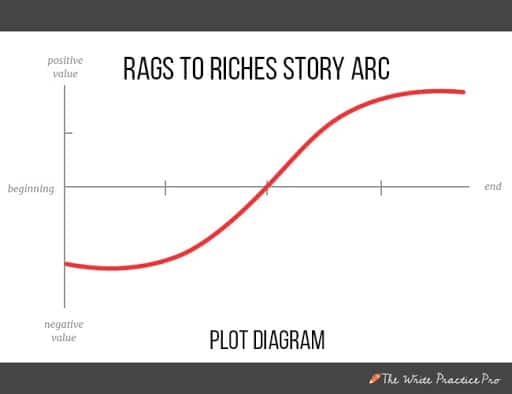
Rags to Riches Plot Diagram
Rags to riches is one of the most basic plot diagrams. A character starts in a bad place at the start and things get better and better.
Here's how the plot points work in rags to riches:
- The exposition sets up the protagonist's generally negative situation in life.
- The inciting incident presents an exciting opportunity to improve their life, in some way.
- During the rising action, things are getting better, but also more complicated, with new problems, and (likely) villains, constantly appearing, threatening all their gains.
- In the dilemma, the protagonist faces an impossible choice, likely about how to keep all their gains or risk losing them.
- The climax plays out the choice the protagonist makes, and how they ultimately triumph.
- The denouement resolves the plot with a happy ending.
This is a relatively simple plot diagram. Now, let's look at a few more complicated shapes.
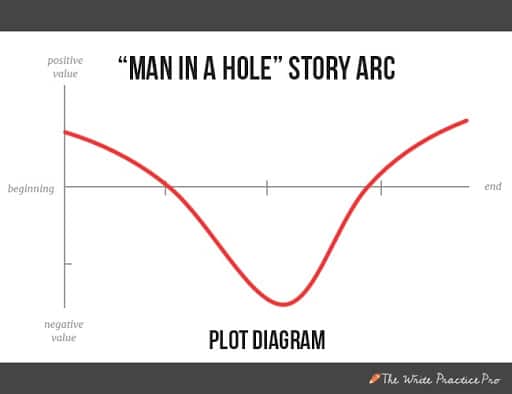
Man In a Hole Plot Diagram
In a “man in a hole” story arc, a common arc, the main character starts out in a good place, gets into trouble, and then gets themself out of it, to finish the story with a happy ending.
Here's how the plot points work for a man in a hole arc:
- The exposition sets up the character's generally good situation in life.
- The inciting incident pushes the character into a hole, a problem that worsens throughout the rising action.
- The rising action contains all of the plot between the descent into the hole to the character getting themself out of it. The turning point of the story comes at some point in the middle of the rising action (sometimes called the midpoint) when the main character begins to get themself out of the hole.
- However, the main character faces a final dilemma, one that threatens to push them back into the hole.
- In the climax, they finally climb all the way out of the hole.
- In the denouement, we see the resolution of their situation and how they're once again enjoying their lives.
Related to the man in a hole arc is the “double man in a hole” arc.
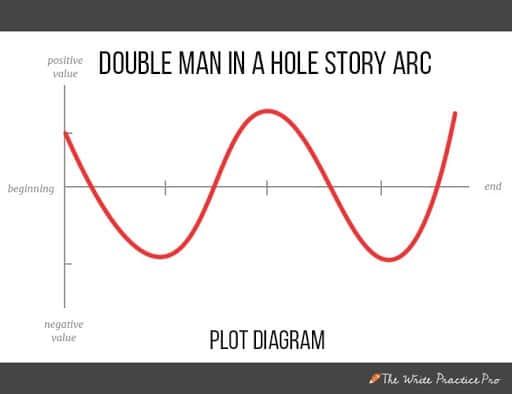
Double Man In a Hole Plot Diagram
Building upon the “man in a hole” arc is the “double man in a hole” arc, one of the most popular shapes for stories, appearing in many bestselling novels and blockbuster films. Like man in a hole, it begins with a character who is in a great place, but soon gets into trouble. They get themself out of trouble, but then they get back into trouble again. Finally, they get back out of trouble, and the story ends with a happy ending.
Here's how the plot elements work in this arc:
- The exposition, as always, introduces us to the protagonist, their world, and the elements that will soon interrupt their general well-being.
- Like the man in the hole story arc, the inciting incident in a double man in a hole arc pushes the main character into a hole, a problem or situation.
- The rising action of this story arc contains a lot of movement, as the problem worsens before reaching a turning point (sometimes called a pinch point) when things begin to improve before reaching the midpoint. However, soon after, the main character descends into another hole, perhaps caused by the same problem or a new one.
- The dilemma occurs at some point in this second hole, likely at or near the bottom.
- This is followed by the climax, in which the protagonist's choice plays out.
- The denouement resolves the story with a happy ending.
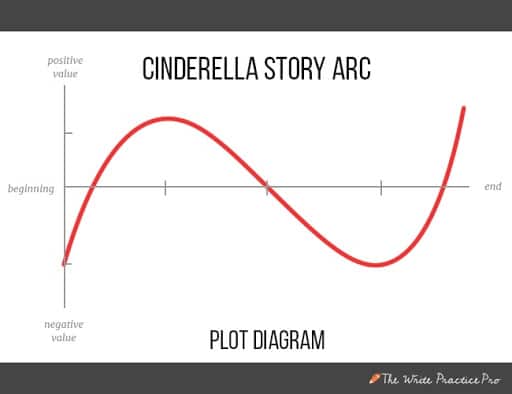
Cinderella Plot Diagram
Another story arc with a happy ending, one especially popular in romantic comedies, is the Cinderella arc.
Here's how it works with the six elements:
- In the exposition, the main character is in a very bad place.
- The inciting incident is actually a positive event, often a meet cute or a potential opportunity.
- From there, the character slowly improves their station through the rising action, until a turning point flips them back to their original low and perhaps beyond.
- The dilemma often occurs in a “dark night of the soul” place or immediately after.
- This is followed by a climax in which the character's fortunes dramatically rise.
- The denouement resolves the story with a happy ending.
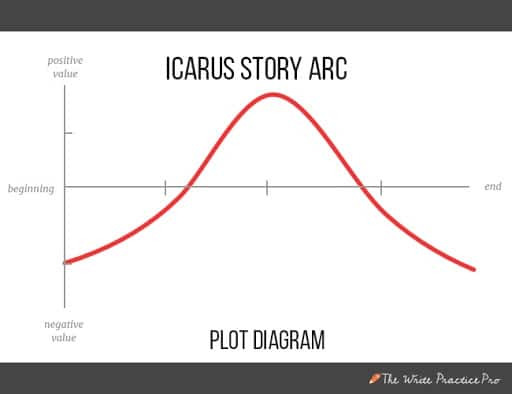
Icarus Plot Diagram
The Icarus arc is quintessential tragedy.
The plot elements usually are usually arranged like this:
- The protagonist begins low in the exposition.
- Their fortunes begin to improve after an inciting incident.
- Things continue to improve in the rising action, culminating in a midpoint turning point, when things begin to go terribly wrong. The protagonist struggles to hold on to their good fortune.
- The unravelling increases right up to the dilemma, which ultimately seals their fate.
- The final, inevitable tragic climax confirms the tragedy.
- The denouement “resolves” the plot with the characters, and audience, reflecting on the result.
This last plot diagram might look the most recognizable, since it's the shape that is used most in plots, originating with Freytag himself.
However, it's built on a misunderstanding of how plots move. All stories do not follow this exact shape, and by forcing stories into this shape, we only cause confusion.
The one requirement is that a story must move, there must be some kind of change, but the shape that story takes is widely variable.
For more on this, including the six main shapes stories can take, plus the three bestselling story arcs, check out our full story arc guide here.
Can Your Story Have More than One Plot? Main Plots, Subplots, and Internal Plots
Most great stories, if you dissect them, are made up of not one but two or three plots. You have:
- The Main Plot, which contains most of the scenes of the story
- The Subplot, while not the main plot, usually deepens the story and adds another dimension (love stories make up roughly ninety percent of subplots)
- The Internal Plot, which shows the development of the main character as they grow in maturity or selflessness
If you want to learn more about how to use subplots, I recommend checking out our full subplot guide here.
The Components of Plot: Examples
Let’s look at a few examples of plot elements at work in two well known stories.
Harry Potter and the Sorcerer's Stone by J. K. Rowling
Also known as Harry Potter and the Philosopher's Stone to those familiar with the U.K. version.
- Exposition: We’re introduced to the Dursleys and to Harry, our protagonist and main character.
- Inciting Incident: Harry is sent a letter that, we learn later, accepts him into Hogwarts, an academy of magic, sending the Dursleys, who deny the existence of magic, into a fit, and causing Mr. Dursley to confiscate the letters.
- Rising action/progressive complications: We meet Hagrid who puts an end to the Dursley's reign of terror; we go shopping for school supplies; we learn about Voldemort; we arrive in Hogwarts; and there’s a troll loose in the dungeons. Our heroes realize that all the strange things happening in Hogwarts have to do with Voldemort.
- Dilemma: Do Harry and his friends go into the dungeon to save the sorcerer's stone and risk possible death and almost certain expulsion, or do they turn back and allow Voldemort to capture the stone and return to full strength.
- Climax: Holy crap, (SPOILER, if you somehow haven't read this book) it’s Quirrel! All the conflict and questions have led to this point; we see Ron’s skills with chess and Hermione’s unusual intelligence combined with Harry’s flying skills to lead to this amazing moment, in which Harry has to make a choice: to side with evil and possibly get his parents back, or choose to continue to suffer that grief and fight the evil bad guy.
- Resolution: Harry wakes up in the hospital wing. The major issue of the story was addressed in the climax, but now, Dumbledore wraps up the few loose ends, tells Harry what happened, and shares some of the consequences of Harry’s decisions. (“What happened down in the dungeons between you and Professor Quirrell is a complete secret, so, naturally the whole school knows” is one of my favorite lines in any book ever.) Oh, and the Gryffindors Win Everything. Then, he’s heading back home, looking forward to next year, and while there are still questions and challenges ahead of him, enough has been resolved that the reader can put the book down with a contented sigh. (Or in my case, turn right back to page one and start again. Ahem.) Harry’s new normal has been established.
To Kill a Mockingbird by Harper Lee
- Exposition: We’re introduced to the town of Maycomb, to the Finch family (Atticus, Scout, and Jem), and to the setup of racism in the deep south of 1930s Great Depression America.
- Inciting Incident: Atticus, a lawyer, agrees to defend Tom, a black man, on charges of raping a white woman—placing him in direct conflict with pretty much everybody in the town, especially Bob Ewell, the father of the white woman accusing Tom.
- Rising action/progressive complications: The investigation and then the trial ensues. A mob attempts to lynch Tom, until Scout diffuses the situation. Then, the courtroom scene. Ouch. Racism wins out over justice, and it looks like Tom is going to be executed.
- Dilemma: Scout must decide whether to give up hope in humanity and the possibility of true justice (like Jem) and end up jaded and mistrustful, or continue hoping that people can be good (like Atticus) and risk being naive and disappointed.
- Climax: Bob Ewell, humiliated by the trial, vows revenge, confronting Jem and Scout at night on their way home alone. In the struggle, Ewell breaks Jem's arm. However, Boo Radley, their hermit neighbor, rescues them, finally giving Scout the chance to see him.
- Resolution: At the end of the story, Scout reaches a complicated and painful but honest conclusion: everyone is a person with good and bad to them, and injustice is unfortunately a deeply ingrained part of the system. Scout has grown in maturity, even at the cost of her innocence.
(By the way, K.M. Weiland has an incredible database of stories in which she breaks down the plots of movies and books alike. Check it out and enjoy.)
Plot Questions to Ask Yourself
So how do you achieve an amazing plot structure? There are a few simple questions to ask yourself about every scene that can help you whittle away problems and connect what needs connecting.
- For Exposition: What is “normal” at the beginning of this book? Remember, your character needs to grow and change, and the loss of this normal is part of the price paid.
- For Inciting Incident: What kind of story are you telling? Each story type has a unique type of inciting incident, and it's good to be familiar with them. Check our inciting incident guide for all the types.
- For Rising Action: What’s at stake? What’s the cost if your protagonist blows it? If you can’t answer this, your reader won’t be able to, either. It needs to be built up enough that your reader cares. It can be good to keep a list of the issues and questions you’re creating in this section; there’s nothing more satisfying than to have all the little loose ends wrapped up later.
- For the Dilemma: What impossible choice will your protagonist face? Will they have to choose between two bad things (e.g. sacrifice or self-preservation) or two good things (e.g. love or money)? What are the consequences of that choice? What will happen if that choice doesn't work out?
- For the Climax: How does it all come to a head in the climax? This needs to emotionally be the crux of everything you’ve built up to, and the stakes need to be in genuine danger. If there’s no real threat, then there’s no reason for your reader to care. This climax has to matter, even if it’s about something as simple as selling enough magazines to send a little girl to camp.
- For Denouement: What is “normal” at the end of this book? After the storm passes and the water calms, what has changed? If you’re writing a series, here’s where you’re establishing what “normal” will look like in the beginning of book two. (Note: you can move this step to the end, but I find it’s really helpful if you know where you’re going as you plan.)
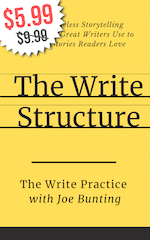
Need more plot help? After you work on practicing this story structure in the exercise section below, check out my new book The Write Structure which helps writers make their plot better and write books readers love. Low price for a limited time!
Get The Write Structure – $9.99 $5.99 »
Do you struggle with any of the elements of plot? Let me know in the comments.
PRACTICE
It’s time to apply this to your writing. For this lesson, you have two options for your practice:
- Create a six sentence plot outline for your story, one for each of the six elements above. Pay special attention to the inciting incident and dilemma.
- Tackle your work in progress. Take one of the components of plot (exposition, inciting incident, rising action, climax, denouement), and show that point in your story.
Set your timer for fifteen minutes and go through one of the plot exercises above.
If you are already a Write Practice Pro member, post your practice here in the Practice Workshop for feedback. Be sure to give feedback to a few other writers and encourage each other.
Not a Pro member yet? You can join us here as a Write Practice Pro monthly subscriber and see what a difference a professional writing community can make as you pursue your writing goals!

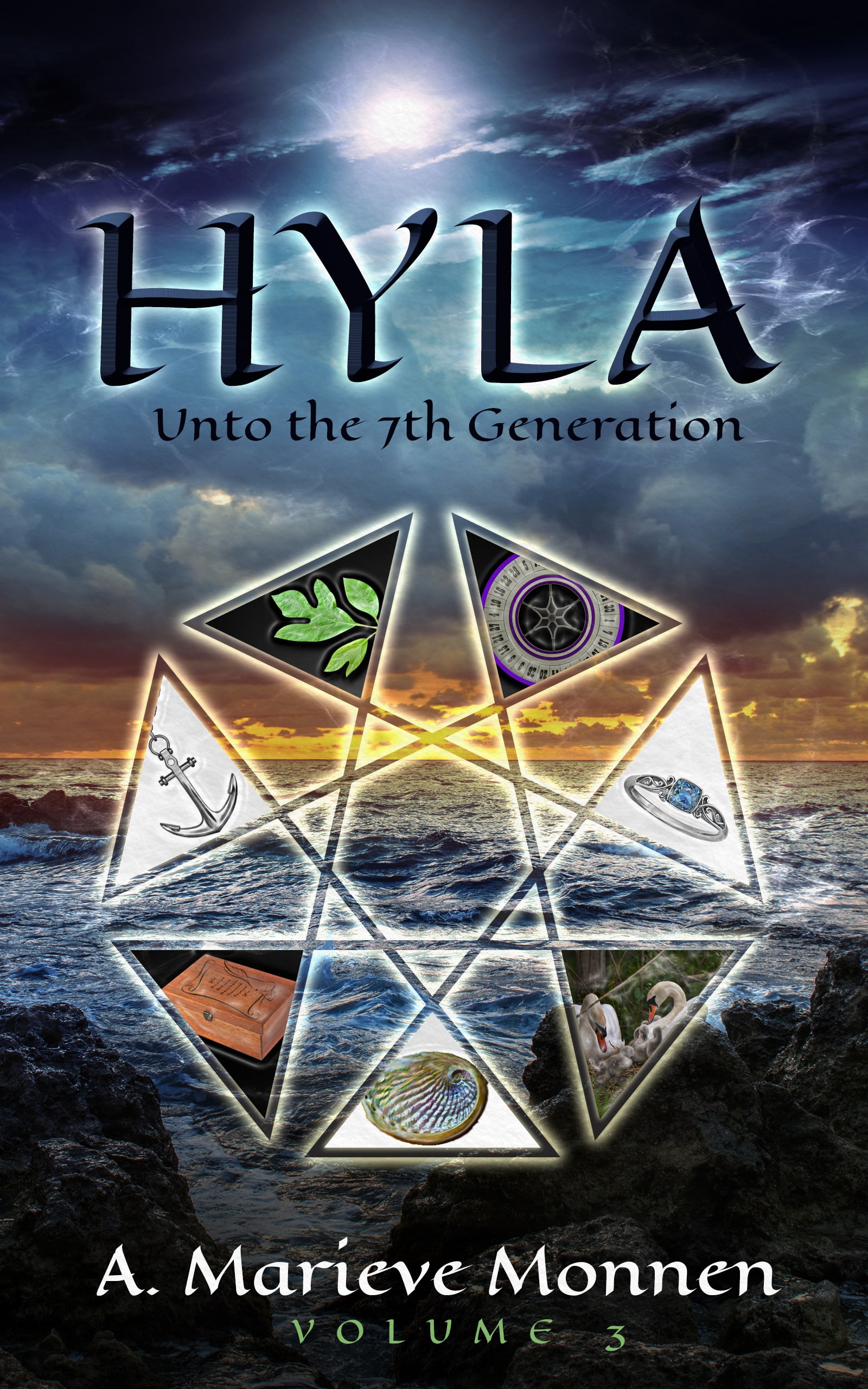
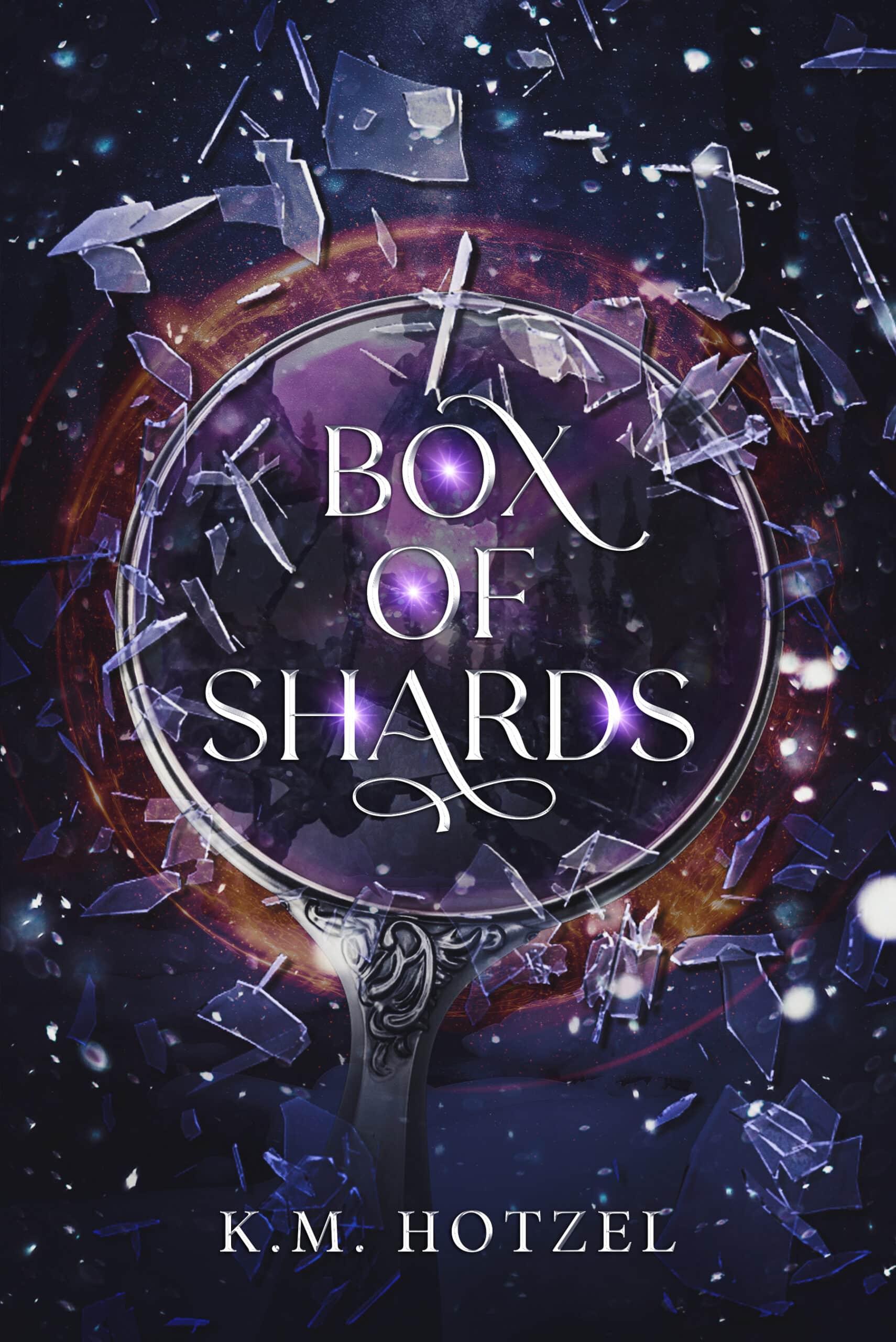
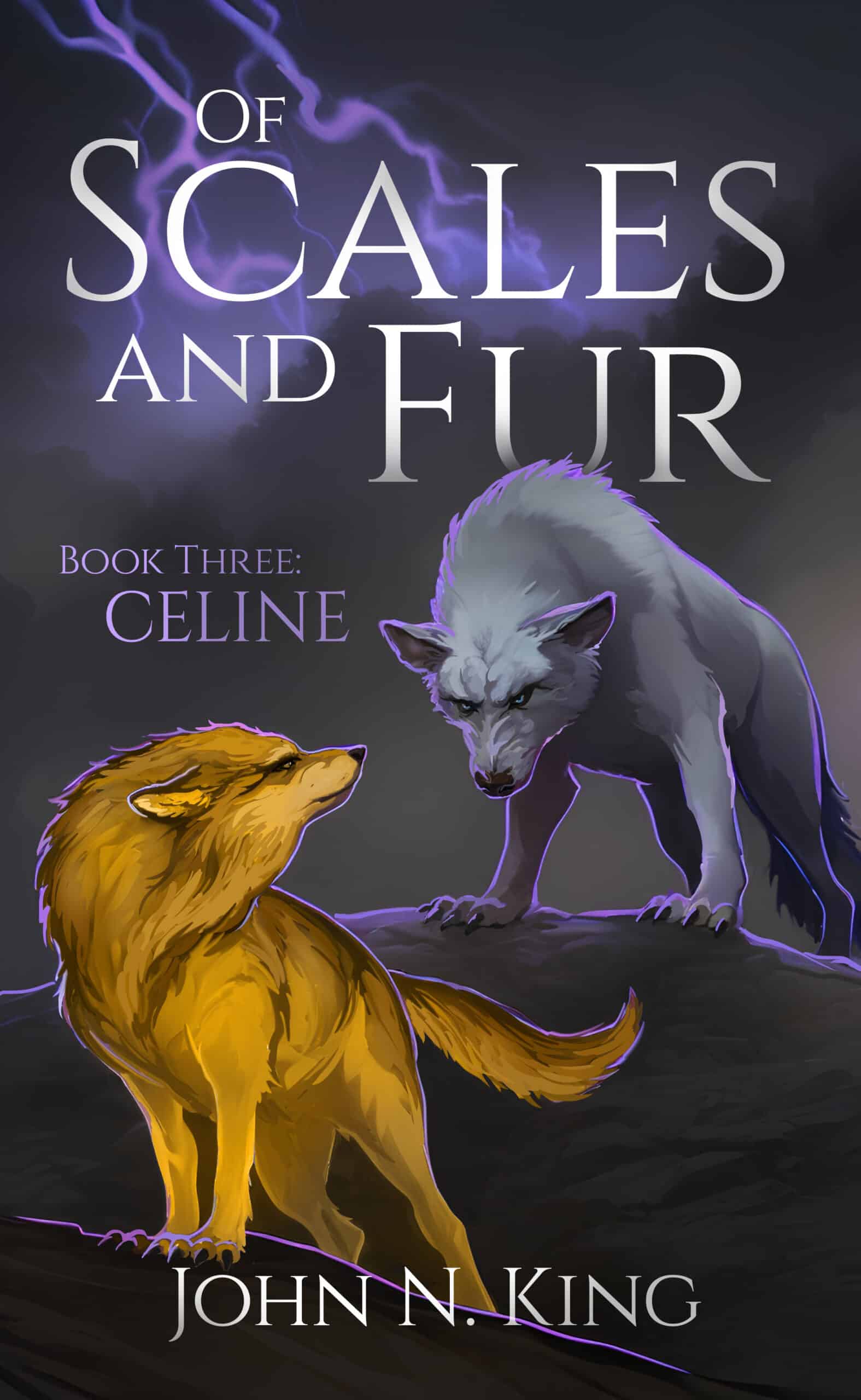
This is a fantastic article. It’s always good brush up on the essential basics of writing a novel. Well done! (Oh, and I looove the wordart!)
I’m delighted to hear it, Catherine! 🙂 Haha, my wordart was so silly – I’m just thrilled you like it!
Hey Ruthanne – I must admit I was overwhelmed a bit by this. In a good way. Makes me humble and also makes me realize how much I don’t know about writing (or have forgotten). This is a keeper and I need to rre and re-read it again. Thank you for your time. nd
Hi, Nancy! I understand completely; it was challenging to re-learn this stuff and try to chip it all down to size.
I know you can do this. Once you get this stuff down, the tools are just SO helpful. 🙂 I really look forward to what you create!
Good morning! I wrote a long post thanking you for your wonderful explanations, but electronic sign-ups got between you, me, and the response, which is somewhere in the netherworld of Disqus, I think.
I look forward to more of your ability!
Ruthanne,
Thank you for this article, I thoroughly enjoyed it. Elegantly put and easy to understand!
So glad to hear it, Nick! 🙂 I hope it helps you in your writing.
For sale: Baby shoes, never worn. (They’re blue, needed pink.). The danger of unsupported assumptions.
I love this optimistic take.
Same!
YAY! I’m sure Hemingway wouldn’t like it, but I’m not always fond of Hemingway. Your version is officially accepted in my mind! 🙂
Thanks, Ruthanne. I haven’t tackled writing structured stories (I write mostly “raw poetry”). (Although a few of my poems do follow the plot structure pretty well.) Your carefully constructed explanation of plot with the examples and link for more is greatly appreciated. I feel it brings me closer to trying my hand at something bigger. Will make time this summer to try it out. Thanks!
How awesome, Susan! That’s great! I really hope you do. 🙂 i can’t wait.
Please note that in many of the best stories the plot serves to deliver the protagonist to her utter disillusionment. Her failure. That’s the role of plot. There, in the heart of the story, she doesn’t do anything as banal as ‘choose’ a new course of action, rather, in the absence of faith in herself, she surrenders and ‘sees’ what her strategies have long obscured. Hero sees a new way of being. (“Rocky”) Many stories end here, even with the hero’s death, (“American Beauty”) and that’s okay, because he’s accomplished the impossible — he’s escaped the prison of his old and outmoded beliefs. Just saying… another way to look at plot… respectfully submitted. ~ PJ Reece
Awesome response, PJ! You just did exactly what I was hoping folks would do – take this fairly basic, low-level explanation and begin to apply it upward. It still falls within those six, but the definitions are expanded. I didn’t want to go there this time around; it’d be confusing. 🙂
A new way of being IS a new normal, following a climax which required reevaluation of everything.
Escaping the prison of old and outmoded beliefs – again, a new normal, following a climax rife with passion and darkness.
Nothing about any of this means it has to be action-based, or even outside the person’s head in any way. It also doesn’t mean it has to be happy (a rude shock for many, I don’t doubt).
I love the way you think. Keep applying and taking it all apart! And DO check out KM Weiland’s Database: http://www.helpingwritersbecomeauthors.com/story-structures/ She heads even deeper into this, touching on bits I didn’t – inciting incidents, pinch points, and more, and it’s fabulous.
Thank you, Ruthanne, for a fantastic post. This one is a keeper!
Deena
Thank you, Deena!
Ruthanne,
Thanks so much for your post. You’ve been thorough in your explaination of a plot and I do appreciate your hard work. How lond did it take you to write such an extensive article?
Thanks, Lilian! A few days, and totally worth every minute. 🙂
Fantastic post. Thanks so much.
Thanks, Beth! I hope you found it helpful. 🙂
Yes. Always more to learn!
Extremely helpful. The bulb (of comprehension) suddenly lit up! Many “WOW” moments as I read through the article..It has sparked my dormant creativity. Thanks a million!
Thomas, that’s fantastic to hear!
Perfect timing on this post. Now that the short story contest is behind me and I’m returning to my “normal” writing this helps clarify some issues I’m encountering with my current works.
And as an aside, one can never have too much Doctor Who 🙂
Hah! Yes. [To the Doctor Who bit!]
No question! 😀
Thrilled to hear that, Michelle! And I do personally agree with your statement about the great DW. 😉
So plot takes the characters through the mire and plunks them down in the worst possible spot in the story and tells them to find their way out (plot driving story) by themselves. Meanwhile, the author throws the kitchen sink at the character(s).
I love your way of phrasing this, Robyn! Plot does something even better, too: what it does is show how each thing that happened led to that worst possible spot. 🙂 It’s all connected!
Thanks to you, Ruthanne, I finally get it. It IS all connected.
I think I got the plot, I think I got the plot. And, I was just wondering, why is there an American book of J.K. Rowling?
It’s my understanding the publishers didn’t think Americans would understand the title with the Philosopher’s Stone, so they changed it to Sorcerers Stone instead. Doesn’t make any sense to me either.
Exactly. I think Americans know the difference between a “Philosopher” and a “Sorcerer.” I an not a fan and won’t ever be one.
Hey! Someone else who admits they are not a fan of Harry Potter! No offense to those who are, but it it just doesn’t appeal to me.
That’s okay. Those of us who are will carry the torch. 😉
Never liked them, but, hey, it looks like she is doing well.
I’m not a fan. That makes two of us. In fact I haven’t read even one Harry Potter story.
Haha! Well, don’t blame the author for that, at least. 🙂
No offense, but, it is an insult to the American who appreciates the culture of literature. But, thank you for your comment, as always.
Hi, LaCresha! Because publishers are weird, is the basic answer. I know this is odd, but Scholastic somehow thought Americans wouldn’t know what a philosopher was.
As Maryan entered the large dining room and headed for the
formed line, which led to the breakfast table, she felt their stares and
mutterings and noted some elbowing and pointing as she passed them. She had grown up with this and was resolved
not to let it bother her, but today she was feeling sensitive.
During her years at White House, she had seen children from
all kinds of backgrounds and dealt with their emotional aftermath that led them
to the House. Most of them grew to be
fine young adults before leaving for employment. The rest tended to keep their emotions and
used them to pick on other children, often getting a reaction from Maryan. Sometimes they targeted Maryan directly;
Jocelin fell into this category.
Maryan joined the line and looked around at the faces in the
room; some averted their eyes, some nodded at her before turning away and
others waved. She waved back thinking ‘No
sign of Jocelin yet’ with relief as she let out a breath.
The smell of fried eggs and rashers hit her nose and made
her stomach rumble. She was sure the boy
in front could hear it. ‘Can you actually hear a stomach rumble? The books say you can. You can certainly feel it!’ wondered
Maryan. She watched the children go to
the tables with their full trays taking care not to spill anything. They went to their usual seats and began to
eat and chat with their companions.
As the line became shorter Maryan was considering her choice
of breakfast when most of the children turned their heads towards the
entrance. The staff continued to serve
the food and the line continued to shorten but the children stopped eating and
darted looks at Maryan and the entrance.
‘Jocelin is here. What will she do today?’ thought Maryan
as she looked towards the entrance.
Jocelin was sauntering towards the line, weaving her way between the
tables, making conversations randomly. Some
children smiled and laughed at what she said, others feigned not to hear and
continued eating, and others paled, held back tears or retaliated. Those that retaliated usually lost their
drink or some of their breakfast. Nothing
was ever done about this, even though the staff and Mother Neate were fully
aware. ‘I wish I knew what she was saying to them kids. One day…one day you’ll get your comeuppance.’
Jocelin reached the line as her eyes locked on Maryan daring
her to look away. After a long moment,
Jocelin’s gaze slowly travelled down and back up to Maryan’s face, realising
she wasn’t going to get a reaction, walked past her and jumped in the line
closer to the serving tables. Maryan
didn’t dare to take her eyes off her until she was in the line in front, only
then did she slowly let out another held breath through her nose.
What happened here? Is Jocelin a bully? Is Maryan somehow “inferior” to Jovelin? Why should Maryan keep looking at Jocelin?
this makes you want to know more? that was the intention!
Wow, what an interesting setup! This Jocelin seems quite frightening, no question. Is this your exposition?
yes that was my thought. this is the norm for Maryan
I struggle with things like keeping the character accountable, and making sure that the climax is horrible enough. Sometimes I get so attached to my characters that I don’t want to harm them (which is what plot demands, and it’s the only way they’ll grow.) But I’ve internalized these rules, and I only pick up these silly mistakes during editing! I think we authors need to be good parents to our characters and give them a chance to fail, so that they can learn to fly.
I understand that! We do need to let them fail; while it’s difficult to write, it makes for amazing reading, and it’s only as we read about other people failing and rising again that we can gain hope for ourselves and our own failures.
Thanks a lot madam.You have solved many arguments.
Sarojini, that’s great! I’m very curious what kind of arguments I’ve solved. 🙂
madam, the’ example of component of plot’ helped me a lot. Earlier I had self doubt. Now I can prepare the component of my own plot.I want to write a novel[ romance].
Thanks a lot madam
Exposition: A man got enlisted in the Vietnam War and had to leave his farm. Because his town was unlisted, he never learned how to get back home. He’s had loves and losses, and wondered from city to city, but still feels that something is missing.
Rising Action: Now he’s an old man, and he learns that his old farm is being torn down to make room for a mall. Without a car, he leaves right where he is and runs across the country to make it in time to stop them. He becomes a sensation, and people who’ve met him from all around the country start talking about him.
Climax: The old man finally makes it to the old farm, but he’s too late. The mayor signs away his land for the mall. The old man pleads, but the mayor doesn’t budge.
Falling Action: However, the mayor allows the old man to look at his farm before it gets torn down. He passes through the farm overcome with moss, and he remembers his childhood and the memories he had in this place. The old man realizes that he’s never had a home like this before, so he decides to stay at the farm.
Resolution: The trucks come to tear it down, but see that he’s still there. The press is around too, and the mayor looks at the press ready to attack and decides to let the old man keep it. He stays at the moss-ridden farm, smiling now that he’s finally home.
Wow! This is a great story; I really like this. There are all kinds of possibilities here. I’d say you nailed that climax just right, too.
Exposition: It was like any other day. Nothing seemed amiss when Kim kissed her Mom goodbye before leaving for school. She was really excited as she was thinking about the conversation she had with her school coach the day before.She was a real jewel, the coach said, she had exceptional talent in basket ball. She dreamed to represent her country in international level basket ball tournament someday. Her coach said that she had it in her.
She had a happy smile on her face just before the truck hit her and everything went black.
Rising action: She opened her eyes in the hospital room. Her whole body was aching. as her eyes adjusted to light, she recognized her parents talking anxiously to someone who seemed to be a doctor. Suddenly the became aware that Kim gained consciousness. They rushed towards her bed and started to utter so many things at a time that she could not make them out properly….
“Are you all right honey?”….”Can you recognize your parents Miss. Lee?”….”You were unconscious for two days”…”we were so worried”…”The truck skidded due to the slippery road”…”The driver died on the spot”….”You had several injuries, but the most serious one was on your leg”…..”Don’t misunderstand us honey. We had to give consent”…”We had no other option”….”All we wanted was to see you alive”….
“SILENCE”, She could not take it anymore, “Mom, Dad, what are you talking about?”
After what felt a life time, the doctor said, “We had to get your legs amputated. Both of them.I am very sorry, Miss Lee.”
“WHAAAAT!!!!!!”
Climax: It had been a year since the revelation in the hospital room. Through out this year she had seen all her dreams getting crushed into nothing. She became dependent on many things on others. She become deprived of many gifts of life she earlier took for granted.
She could not take it any more. She did not like to interact with anyone. She, once a strong woman, could not bear with the looks of pity and sympathy from others. She had had enough.
Her life felt like black hole. Every day seemed to be sucking her life energy a bit by bit.
That is why she thought it a right decision to cut her veins with blade and be done with this ‘good for nothing life’.
Falling action: She opened her eyes in hospital room again. Again she spotted her parents talking to the doctor. Her mother was crying on her father’s solder. At first she felt rueful that someone saved her life, forcing her to go back into that black hole again.
But her mother’s words startled her, “We wanted it to be a surprise for her, doctor. We already arranged everything with the club. Her coach gave an impressive recommendation. We were to take her to the basket ball club where they trained people to play basket-ball while in wheelchair.But, now….”
At that moment she felt what a guilt it was to escape her life, to hurt those parents who cared so much about her, to make them see their only child fighting for life on a hospital bed twice within a year.
” I will start anew. A quitter never wins and a winner never quits.”
Resolution: She kissed her Mom goodbye with a huge grin on her face. It was her big day. The accident, her failed attempt to suicide, her promise to start anew – all seemed far away now. She became a successful basket ball player, representing her country in international tournaments, received many trophies and prizes. Her life was just as she dreamed of and something more. Today she was going to attend a function where she will receive a prize from the Writers’ guild for her first book, “A winner never quits”, which inspired thousands of lives.
Wow, Kikku – what a heavy story! It sounds like you have the five principles really figured out. In fact, I’d actually suggest it’s time for you to go more advanced: http://www.helpingwritersbecomeauthors.com/secrets-story-structure-complete-series/
KM Weiland expands the five principles into sub-points, and she does it brilliantly. If you follow her stuff for the next step, I bet you can make this even better. I’m really impressed! Go for it, and keep writing!
Thanks a lot Madam. Your review really matters to me.
I am definitely going to read KM Weiland’s explanation on this topic. I am trying my best to make my writing better everyday.
I absolutely love your writing.
Oh! Thank u for your support. I am a beginner in this field. So every bit of support means a lot to me.
The wind howled, driving the rain in sideways sheets as Brian sped along the slick roadway. The tires on the Neon were nearly bald, he knew, but there was nothing to be done about it now.
By his calculations he had twenty-two minutes left. Twenty-two minutes to find Christine before they killed her. Or did something worse. That was assuming the kidnappers could be trusted to let her go once he found her. And assuming they wouldn’t reveal his dark secret to the authorities.
A sudden gust of wind threatened to push the car right off the roadway. And then, with the crack of wood and the snap of an electric arc, power lines fell all around him. The neon slammed into the pole that had fallen in its path, causing the driver’s airbag to inflate.
Brian swore under his breath. The force of the airbag had stunned him. It was deflated now, some sort of dust still filling the air.
He knew the electricity from the power lines was passing through the car’s frame now. But if he tried to step out, he would be grounded and the high voltage would pass through him. He looked and saw a power line flopping on the wet pavement, spitting sparks like some sort of demonic snake. Even jumping from the car would be a huge risk.
He looked at the dashboard clock. Christine had less than twenty minutes to live.
Yikes! Is this exposition? It feels like it could be! It all depends on where in the story this moment comes. I’d suggest making sure you capitalize “Neon” every time you use it, but other than that, this looks really good to me.
Oops, my mistake! Neon should be capitalized. I was thinking this would be the climax, although after I wrote it, I realized it could be the rising action. It certainly isn’t normal, although it could be the first part of a story, beginning in the middle of the action and explaining how we got here later.
“Senor Miguel, you make this into a loving home for your beautiful lady or you will lose her forever. I will come back to see you every day, you mean hombre, so do as I tell you. Simple does not have to be uncomfortable”.
Wow. I would never speak to him in this way, preferring to go off and sulk until such time as he might feel sorry for me. Mind you, Estefania had leverage. All she had to do was tell Maria how he was treating me, and the services given to him would blow back at him storm force. Ha-ha!
She walked back, saying that the walk would do her good, and the breeze would blow away any bad feelings she had about the mean hombre. “Manana” were her final words to him, but she hugged me.
During the next three months, I don’t know what I would have done without the help of this feisty Spanish senora. Never once did he ever stand up to her, always a quiet “no problema, Estefania” followed by a hug. She taught me so much, like how to cook a good Valenciano paella, the way to every man’s heart. My first attempt was inedible at best, but she persisted, and over time, I became almost as good as she.
Also, during that first period, Mike showed me how to grow food, deal with the chickens and goats, make repairs to the property. In the evenings, we would read to each other, some English books and some Spanish. For the Spanish books, he would read a little and then translate for me, and when I read from them, he would teach me pronunciation while still doing the translations.
I was becoming quite the little Spanish senorita, and I sensed an element of pride in his responses to me, more loving, more supportive than he had shown before.
At the end of three months, he said that he had a very important task to complete, and set out quite early in ‘4’. He came back with what looked to be a picnic basket, neatly covered in red gingham. I couldn’t believe my eyes when I removed the cover. It was full of all of my favourite cosmetics, perfume, sponges, everything to make a senorita bonita. He also produced a pretty white dress which had a small blue flower pattern on it.
I asked why there was nothing for himself, and he explained that what he had brought for me was a ‘prize’ for the effort and determination I had shown.
When Estefania came to see us later that day, I couldn’t wait to show her what he had brought for me, and I proudly stepped out into the evening sunlight in my pretty dress.
“Santa Maria” were her first words as I walked between her and the falling sun. She whispered to me that it was possible to see my entire body form through the dress, but that was alright because it would keep Mike’s interest up.
The final thee months were as idyllic a time as I had ever lived anywhere, the villa included. The simple pleasures of life in the casita matched any amount of gold and finery. The rewards were boundless, all costing very little but returning so much. Between Mike and Estefania, my life and how I viewed everything had been transformed from that of a spoilt princess into a loving and appreciative woman.
……
The story is a cat and mouse chase, where the mouse is actually a cat too, but the girl hasn’t seen it yet. The guy, Mike, is extremely wealthy, and she has been entrapping him in order to get him and all of his money, maybe even dumping him at some point and keeping all of the cash. He wants the girl while still keeping everything in his control, and he knows exactly what she is trying to do.. This is the final stage.
Posted in Disqus by error. How can I change that?
Gerard bolted upright in bed. This was the fourth night in a row that he had experienced those horrible dreams when you feel that you are falling. He could remember his arms flapping like a bird as the ground came more and more into focus. He felt nauseous.
This had been the worst night of the lot. The previous 3 nights he had woken up well before his face was about to connect with the ground below. In tonight’s rendition though he had fallen like a stone and woken up just a split second before contact. The bed covers had gone everywhere, he must have been tossing and turning as the flapping of his arms in his dream had got more and more vociferous.
“Why was I having these dreams, should I see the doctor?”he asked himself.
The weather had entered into the dry, hot season. The past week had been a scorcher. If the sun itself was not hot enough from 7am to 7pm, the humidity which was normally around 90-100% added a few more to the Celsius or Fahrenheit reading.
“Maybe I haven’t been drinking enough water, and I’ve been dehydrating in the night.” he pondered. That seemed plausible.
He pinched the top of his nose as he tried to clear his head. He leant back and picked up his Rolex from the bedside table.
“Stupid watch.” He struck it a couple of times on the side of his hand and looked again in the hope that the second hand had experienced a mechanical resurrection. No life.
“I knew that price was too good to be true.” He scolded himself for being so gullible at the night market on his recent trip to Thailand. Yet, at the time, it felt so good to have a Rolex on his wrist.
Gerard decided he might as well get up. He made his way to the kitchen of his small apartment that overlooked the illegal market traders in the street below. They do all their selling in the morning before the sun comes out to play.
Gerard had worked really hard to keep to his normal morning rituals. A glass of water only filtered water.
“I must remember to take a bottle with me today.”
Grind the coffee beans. He loved the smell of coffee in the morning. On occasional mornings, he felt it was a shame to mix it with boiling water because he was rather disappointed by the results. He still hadn’t been able to perfect how to use the local coffee to make a perfect cup of coffee.
Whilst the coffee was percolating away in the background, he would do some gentle exercises looking out over the balcony. Nothing too vigorous, just enough to get the blood and oxygen rushing to the heart and brain. Then, he’d walk into his office and open the curtains, turn on the PC and pray to God that it hadn’t died overnight. He was really considering changing to a mac book, but the price always caused him to sweat a little more. “Wait for the sales.” he repeatedly told himself.
He reentered into the study but this time with a steaming hot cup of coffee. It was one of those Mugs that were designed for people with thin fingers. Gerard had thick sausage like fingers, so the heat was starting to make carrying the mug rather difficult.
He took his place in his comfy recliner seat and commenced on the last part of his morning ritual. An hours reading. He had a variable taste when it came to books, blogs, and newspapers. He had all his favorites in his favorite app so he just needed to focus and read away. Then, just as he was comfortable a notification banner rolled onto his screen and revealed he’d received an email.
The banner notification showed who the sender was, and the subject matter.
It read. From: Dad & Mum
Subject: Visit
Gerard lost concentration and the coffee cup slipped from his grasp and fell towards the tiled floor. This time, he wasn’t dreaming, and he couldn’t wake up from the inevitable.
SMASH!
‘We’ve got to do this! Can’t you see how amazing this discovery is?’
‘Ms Watkins, with all due respect, you can’t do this.’
Shelby looked for a moment as though she would protest. ‘You’re right. I can’t.’ She looked at Kendall again. ‘But you can.’
‘Ms Watkins?’
Shelby put a hand on Kendall’s shoulder. ‘I can’t manage people. I can’t run a team; I can’t even run a café. But you, you set up the café, and ran Fossil Fun Day all by yourself. This team needs a leader. But it can’t be me. It’s got to be you.’
Kendall backed away. ‘I can’t lead. I tried it once. I just can’t.’
Shelby folded her arms. ‘Well, we’re not exactly swimming in candidates. We’ve got a misplaced knight, a caveman who should’ve gone extinct millennia ago, a skateboarder, and two out-of-town kids who don’t even have rooms yet. You wanna put an ad in the newspaper? I don’t think we even have money for that.’
‘You don’t understand.’ Everything was closing in, everything was going to happen again. Ms Watkins didn’t know who she was. ‘Putting people’s lives in my hands is a very, very bad idea. Last time – ’
‘I don’t know what happened last time, and frankly I don’t care.’ Shelby was ignoring her. ‘All I know is that this time, we need a leader. It’s your choice. Are you in or not?’
Someone forwarded this post on the very day that I needed to get back to basics with a sagging revision. Your list of questions and your practice exercise were just what I needed. Thank you!